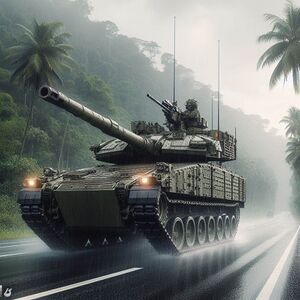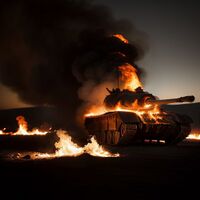YT-1 Caiman Light Tank
| YT-1 Caiman | |
|---|---|
 YT-1 Caiman driving near Forte Gàsco, Marindino Sudé | |
| Type | Light Tank/Tracked Mobile Gun System |
| Place of origin | |
| Service history | |
| In service | 2000 - present |
| Used by | |
| Production history | |
| Designer | Martel Arms |
| Designed | 1993-1996 |
| Unit cost | $Y 6mil |
| Produced | 2000 - present |
| Specifications | |
| Weight | 32,660kg (36 tons) |
| Length | 7.8m |
| Width | 4m |
| Height | 2.7m |
| Armor | Spaced laminate armor base layer, ceramic plate-addons with additional NERA |
Main armament | 111mm/"6 Frag" Rifled Cannon |
Secondary armament | Coaxial 7.62x51mm MG, top-mounted GE-3 14.5x120mm heavy machine gun and top-mounted 7.62x51mm MG |
| Engine | CPP-1984 640hp |
Operational range | 500 km on internal fuel and energy reserves |
| Speed |
|
The YT-1 Caiman is a "light tank", also considered as an "armored mobile gun system", in service with the Inyurstan Army. Developed as a modification of the IAV-90 hull, the YT-1 features improved armor and firepower, while retaining strategic mobility similar to that of a heavy IFV.
Development
During the military reforms of the 90's and the ongoing retirement of 50's - 70's Red Monsoon-era medium tanks, the need arose for heavier armored "punch" for mechanized brigades. Debates ensued among procument officials, both civilian and military, regarding the adoption of more main battle tanks versus more IFVs. However, following the doctrinal adoption of the IAV-74 Carcujo MGS used by lighter wheeled-mechanized brigades and airborne forces, and the purchase of the Mericki-designed LT-46 Orca a.k.a. "YT-4 Alligator" by the Inyurstan Marines; the option was selected for a "light tank" style option.
Requirements for the vehicle included:
- Heavier armor than existing APCs
- Medium-caliber main gun
- Weight less than 40t
YT-1 Contest
In 1992, the Inyurstan Army opened competition for the procurement of a new "light tank", to which Martel Arms, PavCo Arms and [NIFONESE COMPANY HERE] submitted bids.
Martel Arms cooperated with their Mericki counter-parts to secure increased domestic production of the proven 6-Frag gun. This gun was mounted to the IAV-95 chassis, completely removing the ability to carry troops in exchange for the support structure of the turret, and the compartmentalized spare ammo storage. This also offered eased logistical burdens, given that 1) the Inyurstan Army was already using the 6-Frag gun on their IAV-74 Carcujo MGS, and 2) that >90% of the spare parts were in common with the existing IAV-90/95 chassis in service with tracked-mechanized formations. This prototype was dubbed the "M6" and marketed as a "armored mobile support gun".
PavCo Arms went in the opposite direction. Rather than working up from an IFV chassis, they offered a completely new hull design. Two prototypes were built, one with a smaller 90mm rifled cannon, the other with a larger 121mm smoothebore gun. The BT prototypes were also designed to be operated by just 3 crewmen instead of 4; allowin for less space overall and thus less weight (including area needing armor). However, the BT Series offered a significantly weaker hull section and less space for additional ammo in exchange for lower weight and a lower profile. The BT Series were also directly marketed as a "light tank".
Given the cost and logistical considerations, the Inyurstan Army opted for the "M6", and in 2000 ordered the first batch of vehicles - entering them into service and dubbing them the "YT-1 Caiman".
Despite the result, PavCo Arms would later offer their competitor on the foreign market as the "BT-90" and "BT-121", respectively.
Design Features
Armament
The main armament of the YT-1 is the Mericki-designed 111mm "6-Frag" gun; a rifled cannon designed to fire a variety of medium-caliber direct munitions. Unlike the larger YT-3 Crocodile MBT, the YT-1 utilizes a bustle-autoloader with 22 rounds of ammunition stored in the turret bustle, and an additional 18 rounds stored in a compartmentalized section of the vehicle near where the rear crew entrance would be in the earlier IAV-90/95. The 6-Frag gun carries a number of ammunition, including HEAT for multiple target types, HESH rounds for anti-structure capabilities, the gun-launched GPM-21C for engaging enemy main battle tanks, and airburst-HE for anti-infantry and fire support of friendly forces. Alongside the main gun, a coaxial 7.62x51mm machine gun with 400 rounds of ammunition can also be operated by the gunner to engage soft targets.
A top-mounted GE-3-1 14.5x120mm HMG is the second major feature of the YT-1. Carrying 700 rounds of ammunition, this is intended to provide engagement capabilities against infantry behind cover, light vehicles and low-flying aircraft. In later variants, this is replaced by a remote-weapons system, and includes syncing to electro-optical systems to better engage enemy FPV drones.
Lastly, a second 7.62x51mm machine gun is mounted at the commander's hatch, with an additional 500 rounds of ammunition.
Armor
Originally based on the hull of the IAV-95 "Gila II" IFV, the application of frontal ceramic applique and NERA brings the rating up from 20mm to over 45mm (unsustained burst fire), while the turret is completely redesigned and can withstand up to >57mm critical kill or >45mm mission kill (wherein the gun and/or optics would be disabled, but the commander is still protected). Protection on the sides is increased to 30mm (unsustained burst fire). Unlike its IFV forefather, the YT-1 is not anticipated to be operating within extremely close range (<5-10m) of friendly troops, allowing it to mount PEVCOMS ERA in specific locations along the turret and frontal arc.
Recent models of the YT-1 Caiman comes equipped with a number of active protection systems, including both hardkill and softkill. Current models use the Maelstrom Multi-Range Hardkill APS, a system using both short-range directed-energy ERA and a ballistic projectile to defeat incoming threats a wide variety of distances from the vehicle. The LIRDA Softkill APS uses a directed infrared beam to "dazzle" and confuse the warheads on laser and infrared guided warheads.
Survivability
Both the turret bustle and hull compartment are designed with blowout panels; side-facing in the turret and rear-facing in the hull. In case of ammo detonation, the blast is directed away from the crew. Like the IAV-90, the engine is positioned in front of the crew compartment, as a form of "mission kill armor", adding an additional layer of metal between the crew and a penetrating hit.
Performance
Powering the YT-1 is the CPP-1984, a Common Patent Product engine with 640 horsepower. It can reach a top speed of 55km/h on-road, and 40km/h "off-road"; though true performance speed varies greatly on terrain and soil type.
Battery-powered in-hull accessory power units (APUs) are installed in the hull to provide electronic function when the engine is not running, and additional power in later units.
Electronics
Various design iterations of the YT-1 feature a variety of electronical features. Prior to 2007, only the main gunner and commander were equiped with thermal sights. Post-2007 models, the main turret is equipped with the ESQ/GO-19 EOTS - an electro-optical tracking software which allows the gunner to track up to 4 targets simultaneously at ranges of up to 3,000m. This software also allows for easier "lock on" with the GPM-21C gun-launched ATGM. Additional laser-range fighters and crosswind detectors are also used to help the tank's fire control system calculate an accurate estimate of enemy position and factors affecting a shot.
Current iterations of the YT-1 are outfitted with the SOTM-2 forward-looking infrared (FLIR) for the commander & auxiliary gunner, and an independent all-weather, night-vision periscope for the driver.
SICA (Systèméa D'Integration Combatte Área) is a net-centric software that allows the tank to receive necessary uplinks from other Inyurstan units operating nearby. An additional Identification Friend-or-Foe (IFF) is equipped, set to the SACTOCOM-I standard.
Crew
Manned by a crew of four, the YT-1 operates similar to a typical tank. The driver is responsible for navigating and moving the vehicle, while the gunner is tasked with targeting enemy units and aiming the main gun. The commander is responsible for communications, monitoring the vehicles systems, and general command of the vehicle. Further, the commander is also outfitted with independent thermal sights. An auxiliary crewman, usually the most junior, is assigned to the vehicle. Typically, the auxiliary provides constant topside coverage with the HMG; however, as needed the auxiliary may be tasked with assisting in the loading of ammunition from the hull into the turret bustle; either working alongside the gunner to complete the task faster or allowing the gunner to continue targeting while the auxiliary reloads the bustle magazine. The YT-1 can operate with a crew of three, though this is reserved entirely for emergency situations.
History
Following its introduction, the YT-1 Caiman saw extensive service in the Lolloh-Ruol Wars, from the Elescu Campaign to the Final Offensive. In the steppes of Lolloh, the YT-1 was able to prove itself in combat, and the role of the light tank/"armored mobile gun" in general; typically avoiding heavily armored enemy tank units and providing direct fire support (especially against Lollohian concreate field fortifications) to advancing mechanized units. Caimans operating in Dekkar during the Battle of Dekkar were used attached to form of "quick reaction force", lighter sub-brigade level groups of mechanized infantry driving between points in the line helping to repel enemy attacks and cover retreats. During the Lolloh-Ruol Wars, most YT-1 casualties were from man-portable rocket launchers and ATGMs, with combined losses to enemy aircraft and artillery constituting the second largest cause of casualties. Inyurstan Army procurement officers and Martel Arms marketing specializes were quick to jump on these statistics to justify the choice of the M6 prototype as the YT-1 concept and the Inyurstan light tank doctrine overall. On the other hand, critics argue that these stats were the result of commanders explicitly pulling back when encountering enemy armored forces or hesitating to engage mechanized brigades if intel was unclear.
The YT-1 would also see action in the 2018 Bashriyyan-Tifyan War and 2022 Lake Sugogo War. In the latter, the YT-1s played a major role acting as the "forward thrust" of the 12th Brigade de Mixante's push behind Bashriyyan lines. Interestingly enough, the Lake War actually saw the only case of "light tank on light tank" action, wherein Inyurstan YT-1's engaged Bashriyyan armored gun systems to great effect and an aggressively biased casualty ratio - though once again critics argue that these casualty counts were due to other factors such as element of surprise, air superiority, overall famine & dehydration in the Bashriyyan ranks and better intel on the Inyurstan side.
Variants
YT-1 Initial-order production variant. Later all upgraded to YT-1A+ standard.
YT-1A: Standard "ease of operation" model & upgrade standard, including climate control and user-friendly rewiring of electronics display.
- YT-1A2: YT-1A with optical sights upgraded to current generation.
- YT-1A3: YT-1A with optical sights upgraded to current generation, modernized PAVCOMS III ERA package and Maelstrom APS.
YT-1E (Block II): Manned turret replaced by RWS, still under the control of the auxiliary gunner. All thermal & optical sights built-in to latest generation (SOTM-2 FLIR for commander & auxiliary gunner, ESQ/GO-19 EOTS for main gunner, and unnamed night-vision periscope for driver).
- YT-1E2: Software upgrade. RWS and driver's periscopes are now able to operate from power generated by the in-hull APUs.
YT-1M (Block III): 2020+ production model featuring a low-recoil 6-Frag gun, CPP-2017 hybrid diesel-electric engine and an unspecified thermal-signature reducing material on the outer layer.
YT-1MFX: Proof-of-concept variant using a remote station 6-Frag gun to reduce weight and personnel exposure.
